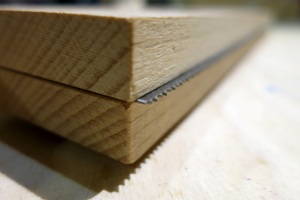When you make guitars you need to make guitar necks. Guitar necks need fingerboards, and unless you build a fretless instrument, you need to cut slots for the frets into the fingerboard. The most common tool is a fret slotting saw (I guess most hobby luthiers don’t have access to a CNC machine, and using a Dremel with a very fine routing bit might be a bit tricky, if you even own such a device).
Those slots must be deep enough to accommodate the tangs of the fret wire so that the crown of the frets actually rest on the surface of the fingerboard but the tangs don’t touch the bottom of the slot by a hair’s width. On the other hand,e the slots shouldn’t go too deep because you don’t want your fretboard to be wobbly. Stability and stiffness is what you want. So making sure you don’t cut too deep is kind of important. But how do you do that?
You use a jig that limits how deep you can cut, and if you don’t have one and don’t want to buy one, you build one. I bought a fret slotting saw (250 mm blade with 16 TPI and a slot width of 0.53 mm by Thos. Flinn (from feinewerkzeuge.de), which looks very much like the fret slotting saw Crimson sell (which I somehow managed not to come across in their shop when I placed my big order; a pity, because they have a decent depth stop, too. On the other hand – more opportunity for building stuff).
I found a depth stop elsewhere, a fancy thing that uses strong magnets to hold a ruler in place, but I didn’t want to spend the price of the saw again for that thing, so I decided to make my own jig. This would have the additional benefit of keeping the blade straight. The blade is rather thin and left to its own devices deviates a bit from the straight and narrow, veering a bit to the left towards the end and while this may not make much of a difference it feels safer to make sure the blade is as straight as possible.
Ok, the blade comes with two 6 mm holes in it, and I plan to make use of them. I bought a strip of beech (10x40mm), cut two pieces the same length as the sawblade to use as blade guides, marked the positions for the holes.
I use a 25 mm Forstner bit to drill recesses to about 4 mm for each hole on the outside of the blade guides, then drill 7mm holes through. I put the blade guides on either side of the sawblade and use M4 bolts to connect them through the holes. The difference between the M4 bolts and the 7mm holes gives the contraption enough play to accommodate all reasonable fret slot depths.
And the blade guides can be pulled below the teeth and fixed in that position to protect the teeth when you don’t use the saw.
The thing works more or less like the depth stops Crimson and other suppliers sell – the idea is to put the lower edge of the blade guides at the necessary distance of the tips of the teeth, fix it there by tightening the bolts, and never again worry about cutting to deep into the fingerboard.
At this point, just a few final touches need to be done. I filed down the ends of the bolts because when the nuts were tightened, they projected beyond the surface of the wood and would have interfered with the ball bearings of the fret slotting rig. Then I sanded the whole thing to 600 grit – this gives the wood a nice silky touch and makes using the jig a real pleasure. Maybe I’ll apply some wax later, I’ll see.








One thought on “Depth Stop for the Fret Slotting Saw”